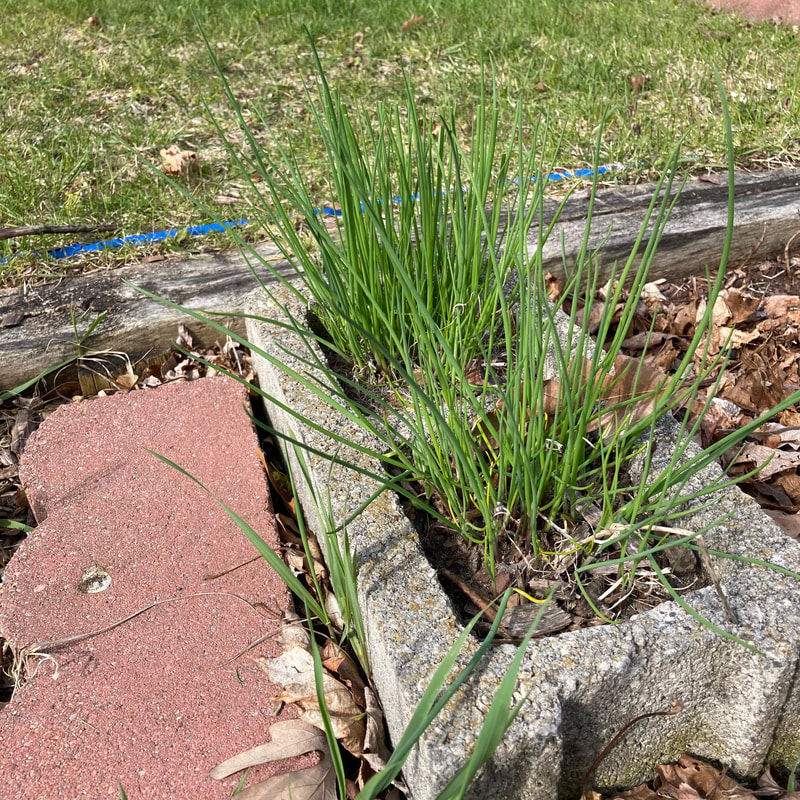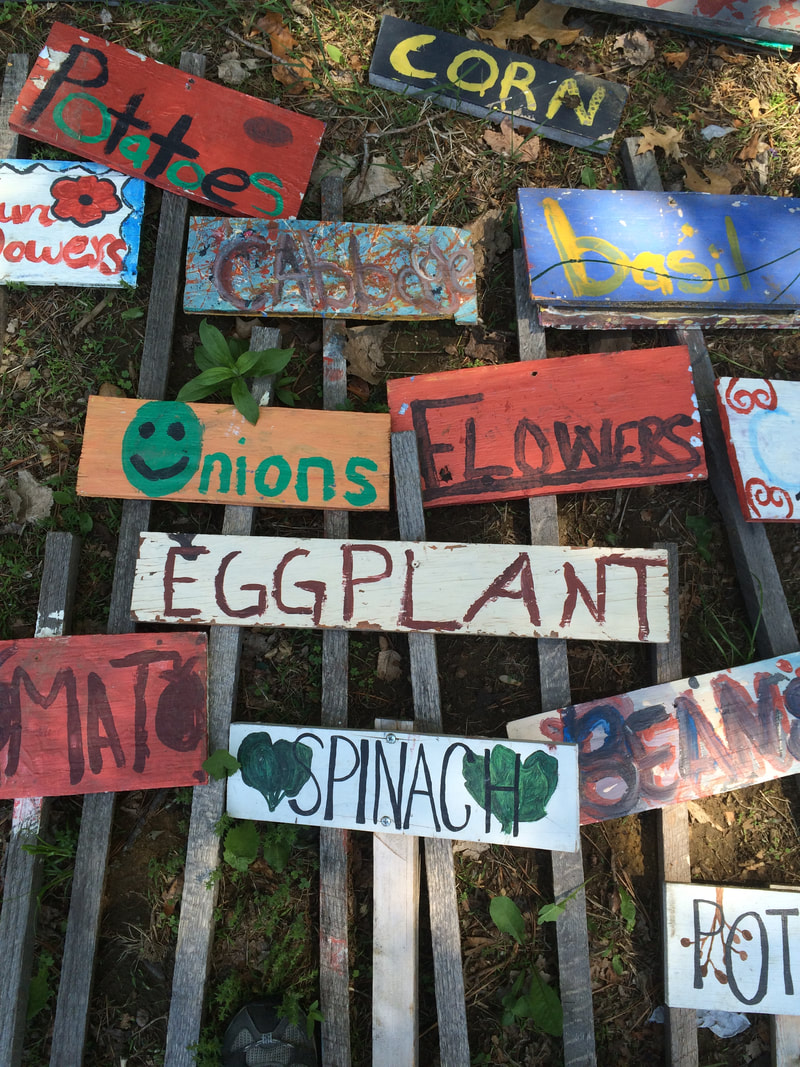|
Photo and article by Donna Iverson
There’s a lot to be said for chives. Whether in the garden, kitchen or medicine cabinet, chives get high marks. First off, you can grow it anywhere. Chives make a great edging for a flower or vegetable garden, can be grown on a deck, on a window ledge or even in an old coffee can. Wherever it is planted it will beautify the spot and protect nearby plants from harmful pests. Deer avoid it. Chives would be at home in a butterfly garden, a cottage-style garden, an herb garden, a flower garden, or a windowsill kitchen garden. It even likes growing in broken down cement blocks, like this one in a nearby community garden. A member of the onion family, chives closest relatives are garlic, shallots, scallions and leeks. It’s pinkish lavender flowers appear in late spring and are the mildest tasting in the onion family. Chives are one of the first plants to break ground in the spring. It’s stalks, called ramps, are edible as is the purple flower which is pretty much recognized by everybody. Chives are used to flavor fish, omelettes, soup, and who hasn’t had a chive garnish on a baked potato with sour cream? An ancient herb native to the New and Old Worlds, chives are high in fiber, vitamins A and K, is an antioxidant and contains choline, which relaxes muscles and can aid in sleep. As for attracting pollinators, chives draw both bees and butterflies. It is one of the top 10 plants for nectar production. Chives is one of the easiest plants to grow making it perfect for new gardeners, children, and anyone with a so-called brown thumb. It likes sun and well drained soil, but that’s about it for requirements. It can be purchased as a small plant at gardening centers and even in the grocery fresh food section. Heirloom organic seeds are also available from catalogs like the Seed Savers Exchange Heirloom Plants at https://www.seedsavers.org. There are many varieties of chives including garlic chives, sometimes called Chinese chives, which have a white flower and a garlicky taste. Fresh chives are so much better than dried chives, like the ones sold in small bottles at grocery stores. Even frozen chives retain their fresh taste. Historically, the Romani used chives for fortune telling and hung it around the house to ward off evil spirits. The Dutch feed it to their cattle to produce a unique milk flavor. So if you want an easy to grow plant, that attracts pollinators, is pest-repellant, is health giving and beautiful, chives fits the bill.
0 Comments
Photo and article by Donna Iverson Of late, the words “regenerative agriculture” keep popping up in gardening literature. Five years ago, the buzz word was “sustainable agriculture.” So what’s the difference? And what’s changed? Basically, sustainable agriculture is about maintaining the health of the soil while regenerative agriculture is improving the soil health to return it to its original quality. Sustainable agriculture aims at not making things worse. Regenerative agriculture seeks to rehabilitate the soil. As a gardener, I wonder what principles of regenerative agriculture could be applied to home gardens or community gardens. Digging a little deeper, I found that some of the principles are already practiced by gardeners like me, such as rotating crops. For example: not planting tomatoes in the same soil every year. Other principles routinely practiced are companion planting and avoiding the use of pesticides. Like regenerative farmers, I plant a diversity of veggies, herbs and flowers in my raised bed. Regenerative agriculture asks farmers to move away from monoculture, like planting all corn or soybeans, and instead plant many plant varieties, including heritage and native plants. One regenerative principle I don’t practice is not tilling the soil. Apparently tilling the soil has destroyed the health of many an acre of land in this country. Farmers have instead added chemical fertilizer to grow their crops. Now they are asked to forgo tilling and allow livestock to restore the soil with natural fertilizer during the off growing season. As a community gardener, I usually double dig my bed each spring before planting. This year I didn’t. Instead I will avoid chemical fertilizer by doubling down on compost. My local community garden has compost bins into which we throw dried leaves, grass and kitchen scraps. Mulching with organic compost accomplishes what regenerative farmers are attempting on a larger scale. But at our next gardening meeting, I may bring up the possibility of purchasing a goat to help regenerate the soil. On the other hand, I think I may be ahead of the curve, as I can already hear neighbors complaining. Guess some serious educating is in order. Baa, baa, baa. Photo and article by Donna Iverson As the snow melts and the temperatures rise, I find myself scanning the ground for any sign of a bloom. First come snowdrops, crocus, and then hyacinth. The colors unfold in shades of white, blue, yellow and purple. Barely noticeable unless you look for them, these small spring flowers push up from the ground when everything else is still weeks away from budding. They have all the look of wild flowers and emerge from bulbs and corms planted in yard or garden in the fall. The regal dark purple Dutch or common garden hyacinth (Hyacinthus orientalis) blooms in March before the trees bud or the grass turns green. It is one of the easiest spring bulbs to grow and its flowers are so fragrant that the French incorporate it into their perfumes. When the Dutch got their hands on it, they bred over 2000 cultivars from this Middle Eastern native. In addition to dark purple, Dutch hyacinth comes in shades of blue, pink, yellow and even red. It is not partial to soil pH, needs no fertilizer and lives about three to four years. Squirrels and rodents love it but if you plant near daffodils, which they avoid, it may be protected. It is also a popular bulb for forcing on your kitchen windowsill in the spring. While the Dutch hyacinth is the most recognizable and popular, there are three other varieties that are less well known. They are the Wood hyacinth (Hyacinthoides hispanica) , the Grape hyacinth (Muscari armeniacum) and the wild hyacinth (Camassia scilloides), which is native to the Great Lakes region. According to my gardening Twin Lake cousin, squirrels devour her Dutch hyacinths while leaving her favorite Wood hyacinths alone. Found in open woods and along streams, the wild hyacinth is a member of the lily family unlike her cousins which are members of the asparagus family. But like her cousins, the wild hyacinth attracts pollinators including bees and butterflies and is heavily scented. Lucky the hiker who crosses its path in one of Michigan’s many woods and state forests. |
Archives
July 2024
Categories |



 RSS Feed
RSS Feed